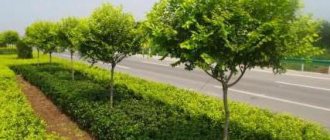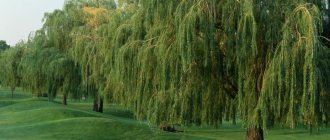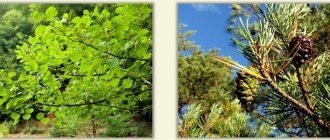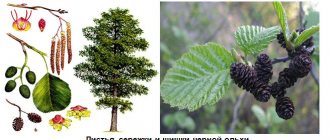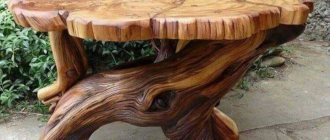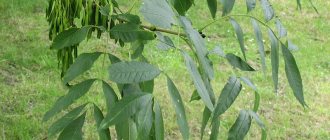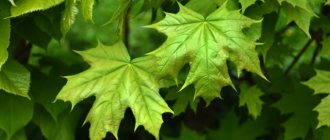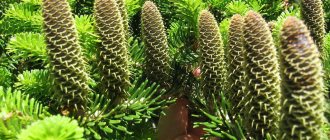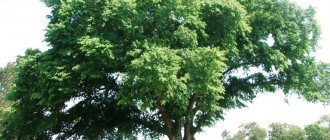- December 1, 2018
- Trees and shrubs
- Lyudmila Selivanova
What is alder, why do some consider it a tree, while others consider it a shrub? Both are true. It all depends on the conditions in which it grows. It can change its shape, taking on the appearance of a deciduous bush with cones, or it can transform and become a branched tree.
Let's talk about this magical tree with small cones, which at one time was considered sacred and was a symbol of fertility.
Myths and legends
There are many myths and legends about this tree. It is talked about in Greek mythology. Orpheus's first musical instrument was an alder pipe. The connection between the pipe and alder can be seen in the name of this musician, which, according to some historians, is a shortening of Orphruoeis - “growing on the river bank,” thereby indicating alder.
The shores of the caves of the sorceresses Sercea and Calypso, who held Odysseus, were overgrown with alder. The myths do not specify what type of alder this or that was, but in nature there are many varieties. The fact that the tree has ancient roots is evidenced by the existence of a certain tribe of Arverni - “people of the alder”, who lived in the territory where the Celts lived.
Alder growing places
The alder tree grows in North America, where it has long been called “alnus,” which translates as “coastal.” It belongs to the Berezov family, as having earrings and cones. The places where alder grows are different. These can be areas with high humidity: rivers, streams, swamps, lakes. It thrives in forest-steppe and mixed forests, where aspen, birch, spruce and oak trees are present. There are various types of alder in the regions of Western Siberia and the Urals. The range of gray alder covers most of Europe; the species is found in Asia Minor and some oases of North Africa. In the Carpathians and Alps it can be found at significant altitudes above sea level.
Rules for planting and care
Alder is very unpretentious to the location and composition of the soil. It grows well in partial shade and full sun, on gummed loams and poor sandy soils. Thanks to its ability to enrich the earth with nitrogen, alder itself will create a nutrient layer for itself and other representatives of the flora. The exception is black alder, which can grow normally only on nutritious and moist soil. It is suitable for improving and strengthening the coastal zone or ravine where groundwater comes close to the surface.
For planting, it is recommended to use soil with a neutral or slightly alkaline reaction. Lime, humus and fertilizer (“Kemira”) are first added to the ground. Planting is best done during the growing season. A layer of drainage material (sand, crushed stone) is laid at the bottom of the planting hole. Then they straighten the roots and fill the free space with fertilized soil. The root collar should be flush with the surface. The earth is watered abundantly and compacted, and the surface is mulched with a layer of chopped straw, peat or wood chips.
Further care for alder is practically not needed. In the year of planting, plants need to be watered more often, while avoiding stagnation of water in the upper layers of the soil. For better aeration of the roots, the soil is regularly loosened and weeds are removed. There is no need to use the tool too deeply to avoid damaging the roots.
Also in the first year you should feed the plants with compost or organic fertilizers. Starting next year, this procedure will no longer be necessary.
In anticipation of wintering, no special measures need to be taken, since alder is highly winter-hardy. She is not afraid of even harsh and snowless winters.
The plant is susceptible to infection with a fungal infection (tafrin genus and others), which leads to deformation of catkins and leaves. When symptoms of the disease appear, it is necessary to carry out a series of fungicide treatments. Of the parasites, the greatest threat is caused by woodworm larvae. They damage the bark of young shoots. To combat them, severely damaged branches are cut off and the crown is treated with an insecticide.
Types of alder
In total, botanists have confirmed the existence of about 40 species of alder. The most common ones include:
- black alder, which is considered one of the best medicinal species;
- gray alder with ovate leaves and shallow roots;
- white, with light gray bark and leaves with double-serrate edges;
- red straight-barrel;
- shrubby alder, growing rapidly.
In addition to the above species, in Siberia and the Far East you can find: Siberian, fluffy, Japanese, Italian, which are interspecific hybrids, and the established names refer more to the places where these types of alder grow.
Kinds
In nature, there are about 40 species of this plant.
Solid alder - can grow as a tree or as a shrub up to 3 meters high. It has flexible branches of yellow or gray-brown color. Earrings are 5-7 cm long, cones are 2 cm. Habitat: Japan.
Elder alder is a tall tree, growing up to 40 m in height. Annual shoots are bright brown and pubescent. It has elliptical leaves, pointed at the top, dark green above, light below. Homeland: Western China. Also common in England, where it was introduced in 1907.
Green alder is a tree or shrub. Maximum height – 20 m. Grows in the Carpathians and Western Europe. Loves sandy loam soils and forms dense thickets called alder forests. Of all types, it is the most frost-resistant.
Siberian alder is a low tree or shrub. It grows in Transbaikalia, Korea and China mixed with conifers. It has round, dark green leaves on top and bluish leaves below. Very rare in culture.
READ Unusual Red Oak
Heart-shaped alder or heart-leaved alder (alnus cordata) is an ornamental plant with beautiful glossy ovoid leaves. They are dark green in color, heart-shaped at the base, pointed at the end, and finely toothed at the edges. Grows in southern Italy.
Kola alder is a low tree, reaching a maximum height of 8 m. It has knotty, twisted branches. Outwardly similar to gray alder. Just like it, it has yellowish, shiny bark on old branches. The leaf petioles are pubescent and red in color. The leaves are oval-elliptical with a blunt apex and serrated edges on the sides. Habitat: Kola Peninsula, on the banks of rivers and lakes.
Black alder is the most common species, growing in the European part of Russia, the Caucasus and Western Siberia. Also found in Western Europe and Asia Minor. Has a dark green crown. Buds, young shoots and leaves are sticky. Valuable species for the woodworking industry. The wood is soft and lends itself well to painting and processing. Waterproof. The leaves and cones are used for medicinal purposes, and the bark is used to make a dye used for dyeing leather.
Red alder is a decorative species, valuable for its bright red color of young shoots and buds. The veins and petioles on the glossy, grey-green leaves are also red. Grows in North America. Loves well-moistened, drained soil. It often settles in burnt areas, renewing and enriching the soil.
Alder tree: description
If we consider the features of appearance, everything depends on the places where it grows, the species to which it belongs, as well as the soils on which it grows. A tree that grows on fertile soil can reach a height of up to 25 meters by the age of fifty. Black alder grows up to 35 meters. What does alder look like on soils with poor fertility? It grows as a bush, living up to 60-70 years.
Alder has a lush crown. But it is not uniform, somewhat sparse due to the uneven arrangement of branches. Alder is one of the first to signal that spring has come. This is manifested in the abundant flowering of the tree. At this time it stands decorated with beautiful earrings, which are divided into men's and women's. Women's earrings are no more than 1 cm in size, and men's ones reach sizes of 5 - 9 cm. The article presents species photos of alder trees and leaves that appear after flowering.
Collection, preparation and storage
It is convenient to harvest alder fruits at the beginning of winter, in dry weather. Annual shoots are cut off with pruning shears or the cones are simply shaken off onto the snow, where they are clearly visible. The length of the cut branches should not exceed 1.5 cm. Harvesters are not recommended to break and tear off branches, as well as cut off the young tips of shoots without cones, since flower buds have already formed on them, which will bloom next spring.
The collected infructescences are laid out in one layer and dried in dryers or in air, turning them periodically. Store raw materials in fabric bags or cardboard boxes for no more than 3 years.
Fruit
Alder cones of different sizes are fruits. Depending on its type, they are filmy and leathery, while others are wingless. The cones hang closed on the alder all winter, opening only in March and sowing the soil with their seeds.
The cone harvest can be harvested in late autumn and winter if the alder grows on a personal plot. When harvesting cones, they are cut with garden shears. The buds are dried at room temperature. Dried fruits become brown or brown in color. They give off a light aroma. They have an astringent taste.
Black alder
Alder blooms in April and is pollinated by the wind before its oval or round leaves bloom. She had prepared for spring flowering the previous summer. It is at this time that men's earrings are laid, which grow and form until late autumn. They have a supply of pollen ready for winter. The fruits of this alder ripen by the spring of next year. They are cones with a narrow wing. This can be clearly seen in the photo of the tree and alder leaves.
The bark is dark in color, and there are a significant number of cracks on old branches.
Black alder is found in North America, Europe, Ukraine and the Baltic countries. Loves wetlands. Sometimes black alder looks like thickets, especially in places where there is a stream or small river. There is even a popular saying: “Where there is good alder, there is heaps of hay.” This type of alder is included in the Red Books of Kazakhstan, Moldova and some regions of Russia. Black alder is quite often used by landscape designers for planting valley parks.
Black alder has a significant number of decorative species, differing in the shape of the leaf blade and the shape of the crown. What does alder of these ornamental species look like? For example, oakleaf has lobed leaves similar to oak leaves; the mountain ash has pinnately lobed foliage; Tsarina has small, more deeply cut leaves. And all this is alder.
Area of application of black alder
A characteristic feature in the description of this type of alder is the value of its wood. In ancient times they knew that it was durable and did not rot, so it was used for lining wells, making barrels and underwater structures. When drying wood, cracks do not form on it. This makes it possible to make musical instruments from it, in particular, flutes and pipes.
In ancient times, shoes were made from wood and alder bark. Due to the pliability and softness of wood, it is used for making sculptures and panels. After felling, alder wood changes its color from white to red. When it is treated with ammonia and drying oil, it acquires a beautiful sheen. Samples of decorative furniture are constructed from such wood. They make amulets, talismans and amulets from alder, sincerely believing that they will help protect both the home and the person.
In folk medicine, alder bark and cones, which contain large amounts of tannins, are used. Young leaves are used to treat purulent wounds, and for diathesis, a decoction of black alder flowers is prepared. Alcohol infusions of alder catkins are used for constipation.
Healing properties of alder
Since ancient times, alder has been used by people for medicinal purposes.
Today, in medical practice, medicines are made from pollen, leaves and alder cones. They are used for diseases of the stomach, intestines, polyarthritis, and colds.
Also, medicinal preparations made from cones are used as hemostatic agents.
Gray alder
Trees of this species can be found on the dry hills of the European part of Russia. This is a low-growing plant, often looking like a large shrub with shallow roots. Gray alder can often be seen on the edge of spruce forests and in fields that once served as arable land. Why is this type of alder called gray? Most likely, this is due to the color of the bark and the shade of the alder leaves, which occurs due to the small edge that gives it a silvery appearance. Further in the article there are photos of the tree and alder leaves, which are ovoid in shape. The slightly pointed tip of the alder leaf gives it a similarity to a birch leaf. Gray alder, like black alder, blooms long before the leaves appear.
As mentioned above, gray alder has shallow roots. Microorganisms settle in them, which, absorbing nitrogen gas from the air, convert it into nitrogenous compounds. Due to this, gray alder is a natural creator of nitrogenous fertilizers. There is another interesting property of the tree: in autumn, alder leaves look green like in spring. The tree sheds its leaves, which are not colored crimson and gold, in preparation for winter. They remain green when they fall to the ground and rot very quickly, improving the top layers of the soil.
Decorative forms of gray alder are varied. For example, blue alder, common in North America, has the form of a shrub or low (6 meters) tree with bluish-colored leaves, sometimes with a lower edge. The golden color of the shoots is reddish, and the leaves are pubescent and slightly yellowish.
There is a variety of decorative gray alder called ugly alder. It has flat, creeping branches.
White alder. Description of the plant
There are more than 40 species of plants, the most widespread species are: Black or sticky alder - grows up to 30 meters in height, has an almost black bark and a spherical crown, does not form root suckers.
Alder gray or white.
White alder grows more than 20 meters in height and has a light-colored bark. The root system is located mainly in the surface layer of soil; on the roots there are nodule growths that contain microorganisms capable of absorbing nitrogen from the air. The leaves are petiolate, ovate or rounded, serrate. Young leaves are densely pubescent, while adults retain pubescence only on the bottom. The plant begins to bloom even before the leaves appear. Alder flowers are yellow-white, dioecious: the male flowers form reddish-yellow long catkins, the female flowers are collected in spikelets with many green fleshy scales. The buds are ovoid-spherical, stalk-shaped, fluffy, slightly blunted at the apex. The alder fruit is an obovate nut with membranous narrow wings. After pollination, the scales darken, become woody and turn into oblong cones. Dark brown or dark brown alder fruits are located singly or in groups on a single stalk. Alder seeds ripen in autumn and are carried by the wind over long distances.
Since ancient times, people have revered alder and considered it a sacred tree
Spreading. Where does it grow
The growing area covers almost the entire territory of Europe, Asia Minor, and North America. On the territory of Russia, white alder can be found in the European part, in the Transcaucasus, in the northern Caucasus, the Urals and Western Siberia. The crop prefers damp places - river valleys and the banks of swamps, and can form thickets.
the plant has concentrated in its composition a lot of biologically active substances that are beneficial to human health
Chemical composition. Medicinal properties and contraindications
The medicinal properties and contraindications of alder are determined by the biologically active substances it contains:
- Triterpene alcohols and ketones;
- Flavonoids;
- Phytoncides;
- Glycosides;
- Antioxidant quercetin;
- Organic acids (chlorogenic, caffeic, protocatechinic);
- Proteins and fats;
- Vitamin C and PP;
- Carotene;
- Essential oils.
Alder exhibits medicinal properties: anti-inflammatory, bactericidal, blood purifying, diaphoretic, astringent, diuretic, antioxidant, and immunostimulating.
The beneficial properties of the plant have a beneficial effect on the function of the gastrointestinal tract and circulatory system. Alder is used for inflammation of the digestive system. Infusions and decoctions of cones and bark are effective for enterocolitis, intestinal infections, dysbiosis, flatulence and pain in the intestines, dysentery. Remedies with alder prevent an increase in the level of bad cholesterol, treat heart disease, hepatitis, and lower blood pressure. Externally used for skin inflammation, burns, viral and bacterial infections of the upper respiratory tract. At the pharmacy you can buy the drug "Themelin" - made from the extract of cones, the drug is used in the treatment of inflammation of the large and small intestines, acute and chronic indigestion.
Area of application of gray alder
The wood is used to make decorative jewelry and furniture. Red, brown and green dyes are obtained from tree bark. Gray alder is not susceptible to rotting in water. Like black, it was used in the foundations of some medieval cathedrals. Many of Venice's cathedrals and castles still stand on alder stilts, as do the watermills of Scotland. The gunsmiths of the Middle Ages knew a lot about alder firewood. They valued the wood as best for charcoal, which was used to melt metal for swords.
Beekeepers know that alder pollen is an excellent food for bees. In folk and official medicine, alder is widely used due to its tannins, vegetable and essential oils.
Infusions from lignified alder cones are used for all kinds of inflammatory diseases of internal organs, as well as in the form of dressings for non-healing trophic ulcers, eczema and burns. A broom made from branches and leaves is an excellent bactericidal agent that tones the skin in the bath.
Use of alder wood
Alder is considered a valuable tree species.
Black alder wood cuts well, but is very fragile.
The wood of growing trees is white, but when the tree is cut down, it begins to change: turn yellow or red.
- The wood is used to make musical instruments because it does not form cracks when dried.
- When in contact with water, it becomes stronger, so wells, barrels, and plywood are made from alder. Thanks to its beautiful color and texture, it has found its application in the manufacture of furniture.
- Wood chips from the plant are used to smoke meat and fish.
- alder bark is used to dye fabrics and leather. The bark is infused for a couple of days and then filtered. To dye it brown, just leave the fabric in this infusion for 20 minutes.
- Used in medicine to relieve pain by applying tree cones and bark to the sore spot; leaves to boils and purulent wounds. Alcohol infusions and decoctions are prepared and used for diathesis and eczema. Baths with leaves help relieve tired legs and relax. The extract from the cones is used in the treatment of stomach disorders, inflammation of the small and large intestines.
- Alder charcoal
Italian alder
Grows in Italy and Albania. This is Alnus cordata - Italian (heart-shaped). The article presents a photo of a tree and leaves of an alder of this species, which is often confused with Alnus subcordata - heart-leaved. Italian alder has an ovoid crown. Its leaves are dense, smooth, oval in shape. They remain on the tree until December. The shape resembles cherry leaves. The bark of the tree is dark brown.
Growing alder in garden plots
Many summer residents like to plant ornamental trees and shrubs in their garden plots, turning part of the plot into a piece of a fairy-tale forest. Alder is no exception, especially since its bark, fruits, leaves, and pollen are good folk medicines that are good to always have “at hand.” You can plant ready-made perennial alder trees, small seedlings purchased from nurseries, seedlings from shoots dug up in growing areas, or wait for the seeds of one or another type of alder planted on the site to sprout.
Alder is a large tree. They have a powerful root system, a height of more than 15 meters, and a well-formed crown. If a sufficiently mature tree is planted on the site, the process is labor-intensive. Here you need equipment that will bring the tree and plant it in the prepared place. Planting can be done at any time, but the best option would be to plant alder in the fall and even in winter, when the tree is least responsive to temperature changes and is at rest.
In central Russia, planting time is from November to March. Caring for a tree planted in this way involves intensive watering and loosening in the first year after planting.
In the nursery you can buy shrubby alder, which reaches a height of 3 meters, or is formed in the form of a small tree, which is rarely taller than 10 meters. Shrub alder grows quickly, is not picky about soil, and requires moisture. Alder will transform even the most inconspicuous piece of a personal plot, turning it over time into a cozy green corner.
Traditional medicine recipes
All parts of the plant - roots, bark, leaves and alder fruit - have been used in folk medicine. Based on them, medicinal decoctions, infusions and tinctures are prepared that help in the treatment and prevention of many diseases.
alder cones have a rich chemical composition and are used in the treatment and prevention of various diseases
With alder cones
For diseases of the stomach and intestines, prepare an infusion of 2 tbsp. l. crushed fruits and a glass of boiling water. Leave for 30 minutes, strain and drink after meals according to Art. l. 3-4 times a day. Helps with pain and discomfort in the stomach, bloating, and digestive disorders.
Alder cones are effective against diarrhea in the form of a decoction of 2 tbsp. l. crushed raw materials and 300 ml. water kept in a water bath for 20 minutes. The product is infused in a warm place for 4 hours and taken one teaspoon at a time. three times a day until symptoms disappear.
To heal cuts, wounds, and burns, an ointment is prepared from the fruits of alder, aspen bark and cinquefoil. A handful of the medicinal mixture is placed in a container with 300 ml. water and in a water bath for 20 minutes. Add alcohol or vodka (50 ml) and vegetable oil (4 tbsp) to the strained and cooled broth, mix everything and store in the refrigerator.
For uterine fibroids, prepare a decoction of tbsp. l. crushed cones and a glass of water. Boil for 3 minutes and leave. The strained drink is consumed three times a day, 2 tbsp. l.
Alder fruits in the form of an infusion relieve irritations of the skin and scalp and reduce hair greasiness. A decoction of earrings is used to make lotions for eczema and diathesis.
For periodontal disease 2 tbsp. l. crushed cones are poured into a glass of boiling water, infused for a couple of hours and taken before meals, 100 ml. three times a day.
Application of bark and leaves
The benefits of alder bark infusion are determined by the presence of tannins, triterpene alcohol and taraxerol, which have a beneficial effect on liver function and promote the removal of bile and excess fluid. Alder bark is used in gynecology for uterine bleeding, inflammation, and uterine fibroids.
A decoction of the bark has an antimicrobial effect, reduces the risk of allergies, helps with colds and rheumatic arthritis, and with furunculosis. To prepare it st. l. crushed bark is poured with a glass of water, boiled over low heat for 10 minutes, and infused. The strained decoction is taken according to Art. l. three times a day.
Bark tincture is used for joint pain, arthritis, gout, and diarrhea. To prepare it, 25 gr. crushed raw materials are infused in a glass of vodka or alcohol. Leave in a dark place for 2 weeks. Take 30-40 drops 2-3 times a day.
With furunculosis Art. l. crushed bark is poured with a glass of water, boiled over low heat for 10 minutes, and infused. The strained decoction is taken according to Art. l. three times a day.
the leaves of the plant have medicinal properties and are used in traditional medicine recipes
An infusion of the leaves helps as a diaphoretic for colds. To prepare it, 20 gr. leaves are dipped into a container with 250 ml. boiling water, wrap and leave for 15-20 minutes. Strain and take 100 ml. three times a day.
A decoction of the leaves is used in the form of baths for tired legs and dermatitis of the feet, as well as for varicose veins. The same product is suitable for washing wounds and abscesses.
The beneficial properties of the leaves are used for mastopathy; they are steamed and applied to the chest several times a day.
Using the root
Alder root has a positive effect on a woman’s health and the function of the reproductive system, has an anti-cancer effect, and is included in many gynecological medicinal products. However, for these purposes, the greatest therapeutic effect is provided by black alder root.
For douching, prepare an infusion: dry crushed root in the amount of 3 tbsp. l. pour a liter of boiling water, infuse and strain. The treatment procedure is carried out at night for 3 weeks, then you need to take a break for a week and repeat the treatment.
The instructions for using products with alder do not recommend use during pregnancy and lactation, children under 12 years of age, or individual intolerance. If abused, side effects may occur in the form of itching or burning in the mouth, swelling or redness of the face.
